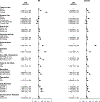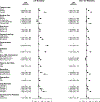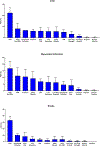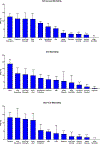Modifiable risk factors, cardiovascular disease, and mortality in 155 722 individuals from 21 high-income, middle-income, and low-income countries (PURE): a prospective cohort study
- PMID: 31492503
- PMCID: PMC8006904
- DOI: 10.1016/S0140-6736(19)32008-2
Modifiable risk factors, cardiovascular disease, and mortality in 155 722 individuals from 21 high-income, middle-income, and low-income countries (PURE): a prospective cohort study
Erratum in
-
Department of Error.Lancet. 2020 Mar 7;395(10226):784. doi: 10.1016/S0140-6736(19)32282-2. Epub 2019 Oct 7. Lancet. 2020. PMID: 31601492 No abstract available.
Abstract
Background: Global estimates of the effect of common modifiable risk factors on cardiovascular disease and mortality are largely based on data from separate studies, using different methodologies. The Prospective Urban Rural Epidemiology (PURE) study overcomes these limitations by using similar methods to prospectively measure the effect of modifiable risk factors on cardiovascular disease and mortality across 21 countries (spanning five continents) grouped by different economic levels.
Methods: In this multinational, prospective cohort study, we examined associations for 14 potentially modifiable risk factors with mortality and cardiovascular disease in 155 722 participants without a prior history of cardiovascular disease from 21 high-income, middle-income, or low-income countries (HICs, MICs, or LICs). The primary outcomes for this paper were composites of cardiovascular disease events (defined as cardiovascular death, myocardial infarction, stroke, and heart failure) and mortality. We describe the prevalence, hazard ratios (HRs), and population-attributable fractions (PAFs) for cardiovascular disease and mortality associated with a cluster of behavioural factors (ie, tobacco use, alcohol, diet, physical activity, and sodium intake), metabolic factors (ie, lipids, blood pressure, diabetes, obesity), socioeconomic and psychosocial factors (ie, education, symptoms of depression), grip strength, and household and ambient pollution. Associations between risk factors and the outcomes were established using multivariable Cox frailty models and using PAFs for the entire cohort, and also by countries grouped by income level. Associations are presented as HRs and PAFs with 95% CIs.
Findings: Between Jan 6, 2005, and Dec 4, 2016, 155 722 participants were enrolled and followed up for measurement of risk factors. 17 249 (11·1%) participants were from HICs, 102 680 (65·9%) were from MICs, and 35 793 (23·0%) from LICs. Approximately 70% of cardiovascular disease cases and deaths in the overall study population were attributed to modifiable risk factors. Metabolic factors were the predominant risk factors for cardiovascular disease (41·2% of the PAF), with hypertension being the largest (22·3% of the PAF). As a cluster, behavioural risk factors contributed most to deaths (26·3% of the PAF), although the single largest risk factor was a low education level (12·5% of the PAF). Ambient air pollution was associated with 13·9% of the PAF for cardiovascular disease, although different statistical methods were used for this analysis. In MICs and LICs, household air pollution, poor diet, low education, and low grip strength had stronger effects on cardiovascular disease or mortality than in HICs.
Interpretation: Most cardiovascular disease cases and deaths can be attributed to a small number of common, modifiable risk factors. While some factors have extensive global effects (eg, hypertension and education), others (eg, household air pollution and poor diet) vary by a country's economic level. Health policies should focus on risk factors that have the greatest effects on averting cardiovascular disease and death globally, with additional emphasis on risk factors of greatest importance in specific groups of countries.
Funding: Full funding sources are listed at the end of the paper (see Acknowledgments).
Copyright © 2020 Elsevier Ltd. All rights reserved.
Figures






Comment in
-
Prevention of premature cardiovascular death worldwide.Lancet. 2020 Mar 7;395(10226):758-760. doi: 10.1016/S0140-6736(19)32034-3. Epub 2019 Sep 3. Lancet. 2020. PMID: 31492506 No abstract available.
-
Causal ordering among risk factors in the PURE study.Lancet. 2021 Jan 23;397(10271):278. doi: 10.1016/S0140-6736(20)32404-1. Lancet. 2021. PMID: 33485448 No abstract available.
References
-
- GBD 2017 Risk Factor Collaborators. Global, regional, and national comparative risk assessment of 84 behavioural, environmental and occupational, and metabolic risks or clusters of risks for 195 countries and territories, 1990–2017: a systematic analysis for the Global Burden of Disease Study 2017. Lancet 2018; 392: 1923–94. - PMC - PubMed
-
- Yusuf S, Hawken S, Ounpuu S, et al. Effect of potentially modifiable risk factors associated with myocardial infarction in 52 countries (the INTERHEART study): case-control study. Lancet 2004; 364: 937–52. - PubMed
-
- O’Donnell MJ, Chin SL, Rangarajan S, et al. Global and regional effects of potentially modifiable risk factors associated with acute stroke in 32 countries (INTERSTROKE): a case-control study. Lancet 2016; 388: 761–75. - PubMed
-
- Teo K, Chow CK, Vaz M, Rangarajan S, Yusuf S, PURE Investigators-Writing Group. The Prospective Urban Rural Epidemiology (PURE) study: examining the impact of societal influences on chronic noncommunicable diseases in low-, middle-, and high-income countries. Am Heart J 2009; 158: 1–7.e1. - PubMed
Publication types
MeSH terms
Grants and funding
LinkOut - more resources
Full Text Sources
Other Literature Sources
Medical
Research Materials

